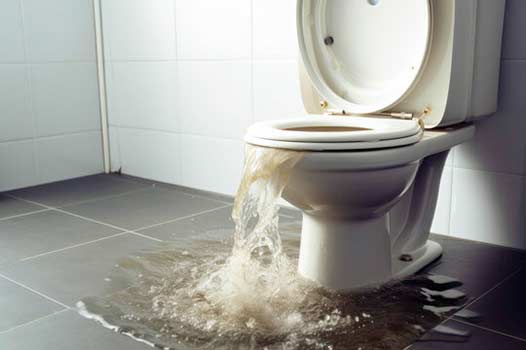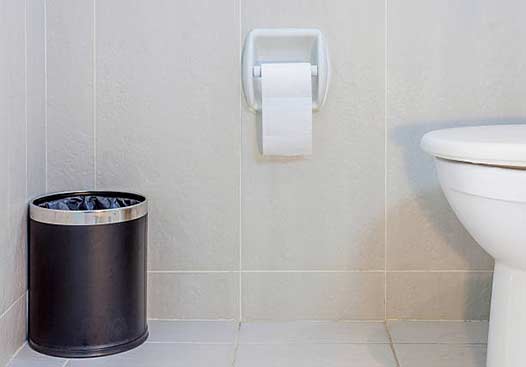
To effectively address a toilet overflow, it is crucial to understand the underlying causes. Several factors can contribute to this issue, including blockages in the plumbing system, malfunctioning components within the toilet, and external factors such as sewer line problems. Identifying the root cause is the first step in preventing further complications and finding a lasting solution. Common causes include:
- Blockages in the Plumbing System: Blockages can occur due to the buildup of debris, such as toilet paper, sanitary products, or foreign objects. These blockages can obstruct the flow of water, leading to overflow.
- Malfunctioning Toilet Components: Components such as the flush valve, fill valve, and flapper can malfunction, causing continuous water flow and potential overflow.
- Sewer Line Problems: Issues with the sewer line, such as blockages or damage, can prevent proper drainage and lead to toilet overflow.
Immediate Actions to Stop the Overflow: Quick Steps to Prevent Damage
When faced with an overflowing toilet, quick action is essential to minimize damage and prevent the situation from worsening. Follow these immediate steps:
- Turn Off the Water Supply: Locate the shut-off valve behind the toilet and turn it clockwise to stop the flow of water. This will prevent additional water from entering the toilet bowl and causing further overflow.
- Lift the Float: If the shut-off valve is not accessible or functional, remove the lid from the toilet tank and lift the float. This will stop the flow of water into the tank and bowl.
- Use a Plunger: If the water level in the toilet bowl is not too high, use a plunger to attempt to clear the blockage. Ensure a tight seal around the drain and apply firm, consistent pressure to dislodge the obstruction.
- Contain the Overflow: Use towels or a mop to contain the overflow and prevent water from spreading to other areas of your home. This will help minimize water damage.
Cleaning Up After an Overflow: Ensuring Hygiene and Preventing Damage
Once the immediate overflow has been stopped, it is important to clean up the affected area to prevent damage and maintain hygiene. Follow these steps:
- Remove Excess Water: Use a wet/dry vacuum or absorbent towels to remove standing water from the floor. Be sure to wear gloves and take necessary precautions to avoid contact with contaminated water.
- Disinfect the Area: Clean and disinfect the floor, walls, and any affected surfaces using a bleach solution or disinfectant cleaner. This will help eliminate bacteria and prevent the spread of germs.
- Dry the Area Thoroughly: Use fans, dehumidifiers, or open windows to ensure the affected area is thoroughly dried. This will help prevent mold and mildew growth.
- Dispose of Contaminated Materials: Properly dispose of any contaminated materials, such as towels or cleaning supplies, to prevent the spread of bacteria and germs.
Preventing Future Toilet Overflows: Proactive Measures for Peace of Mind
Taking preventive measures can help avoid future toilet overflows and the associated complications. Consider the following tips:
- Regular Maintenance: Schedule routine inspections and maintenance for your plumbing system to identify and address potential issues before they escalate.
- Avoid Flushing Non-Flushable Items: Educate household members about what can and cannot be flushed down the toilet. Items such as wipes, feminine hygiene products, and paper towels should be disposed of in the trash, not the toilet.
- Install a Toilet Overflow Prevention Device: Consider installing a toilet overflow prevention device, which can help detect and stop overflows before they cause significant damage.
- Monitor Water Usage: Be mindful of your water usage and avoid excessive flushing. This can help prevent strain on your plumbing system and reduce the risk of overflows.
When to Call a Professional Plumber: Knowing When to Seek Expert Help
While some toilet overflows can be resolved with DIY methods, there are situations where it is best to call a professional plumber. Seek professional assistance if:
- Persistent Blockages: If you experience frequent toilet overflows despite your efforts to clear blockages, there may be a deeper issue within your plumbing system that requires professional intervention.
- Sewer Line Issues: If you suspect that the overflow is caused by a problem with the sewer line, such as a blockage or damage, it is essential to contact a plumber to assess and address the issue.
- Extensive Water Damage: If the overflow has caused significant water damage to your home, a professional plumber can help mitigate the water damage and ensure proper repairs are made.
- Unfamiliar Plumbing Components: If you are unsure about the plumbing components or how to address the issue, it is best to seek professional help to avoid causing further damage.

If you suspect that the overflow is caused by a problem with the sewer line, such as a blockage or damage, it is essential to contact a plumber to assess and address the issue.
Understanding the Role of Plumbing Components: Key Parts to Know
To better manage and prevent toilet overflows, it is helpful to understand the key components of your toilet and plumbing system. Familiarize yourself with the following parts:
- Flush Valve: The flush valve controls the release of water from the tank into the bowl. A malfunctioning flush valve can lead to continuous water flow and potential overflow.
- Fill Valve: The fill valve regulates the water level in the toilet tank. If the fill valve is not functioning correctly, it can cause the tank to overfill and lead to overflow.
- Flapper: The flapper is a rubber seal that covers the flush valve opening. If the flapper is damaged or not sealing properly, it can cause water to leak into the bowl and potentially overflow.
- Overflow Tube: The overflow tube prevents the tank from overflowing by directing excess water into the bowl. If the overflow tube is blocked or damaged, it can contribute to toilet overflow.
Addressing Common Toilet Overflow Myths: Separating Fact from Fiction
There are several myths and misconceptions about toilet overflows that can lead to ineffective solutions. It is important to separate fact from fiction to properly address the issue:
- Myth: Using Chemical Drain Cleaners is Always Effective: While chemical drain cleaners can sometimes clear minor blockages, they can also damage your plumbing system and are not always effective for severe clogs.
- Myth: Flushing Twice Will Solve the Problem: Flushing multiple times can exacerbate the overflow by adding more water to the bowl. It is better to address the root cause of the blockage.
- Myth: Toilet Paper is Always Safe to Flush: While toilet paper is designed to be flushable, excessive amounts or certain types of toilet paper can still cause blockages. Use toilet paper sparingly and opt for septic-safe varieties.
- Myth: Overflows Only Happen in Old Toilets: Overflows can occur in toilets of any age. Regular maintenance and proper usage are key to preventing overflows, regardless of the toilet’s age.
Impact of Toilet Overflows on Your Home: Understanding the Consequences
Toilet overflows can have significant impacts on your home, including structural damage, health hazards, and financial costs. Understanding these impacts can help you take the necessary steps to prevent and address overflows:
- Structural Damage: Prolonged exposure to water can weaken the structural integrity of your home, leading to issues such as warped flooring, damaged walls, and compromised foundations.
- Health Hazards: Overflowing toilets can introduce harmful bacteria and pathogens into your living environment, posing health risks to you and your family. Proper cleanup and disinfection are crucial to mitigate these risks.
- Financial Costs: Repairing water damage and addressing plumbing issues can be costly. Preventive measures and timely intervention can help minimize these expenses.
- Mold and Mildew Growth: Standing water and damp conditions can promote the growth of mold and mildew, which can cause respiratory issues and other health problems. Thorough drying and cleanup are essential to prevent mold and mildew growth.
Environmental Considerations: Reducing Your Impact
Toilet overflows can also have environmental implications, particularly in terms of water waste and contamination. Consider the following points:
- Water Waste: An overflowing toilet can waste a significant amount of water, contributing to higher utility bills and unnecessary strain on local water resources. Addressing overflows promptly can help conserve water.
- Contamination: Overflowing toilets can introduce contaminants into your home’s water supply and local water bodies. Proper disposal of waste and maintenance of your plumbing system can help prevent environmental contamination.
- Eco-Friendly Cleaning Products: Use environmentally friendly cleaning products when disinfecting and cleaning up after an overflow to minimize your impact on the environment.
- Efficient Water Fixtures: Consider installing water-efficient toilets and fixtures to reduce water usage and the risk of overflows. These fixtures can help conserve water and reduce your environmental footprint.
Conclusion: Effective Management and Prevention of Toilet Overflows
Dealing with a toilet overflow can be a stressful and challenging experience, but with the right knowledge and actions, you can effectively manage the situation and prevent further complications. By understanding the causes, taking immediate steps to stop the overflow, cleaning up properly, and implementing preventive measures, you can protect your home and ensure the proper functioning of your plumbing system. Remember, when in doubt, it is always best to seek the assistance of a professional plumber to address persistent or severe issues.

